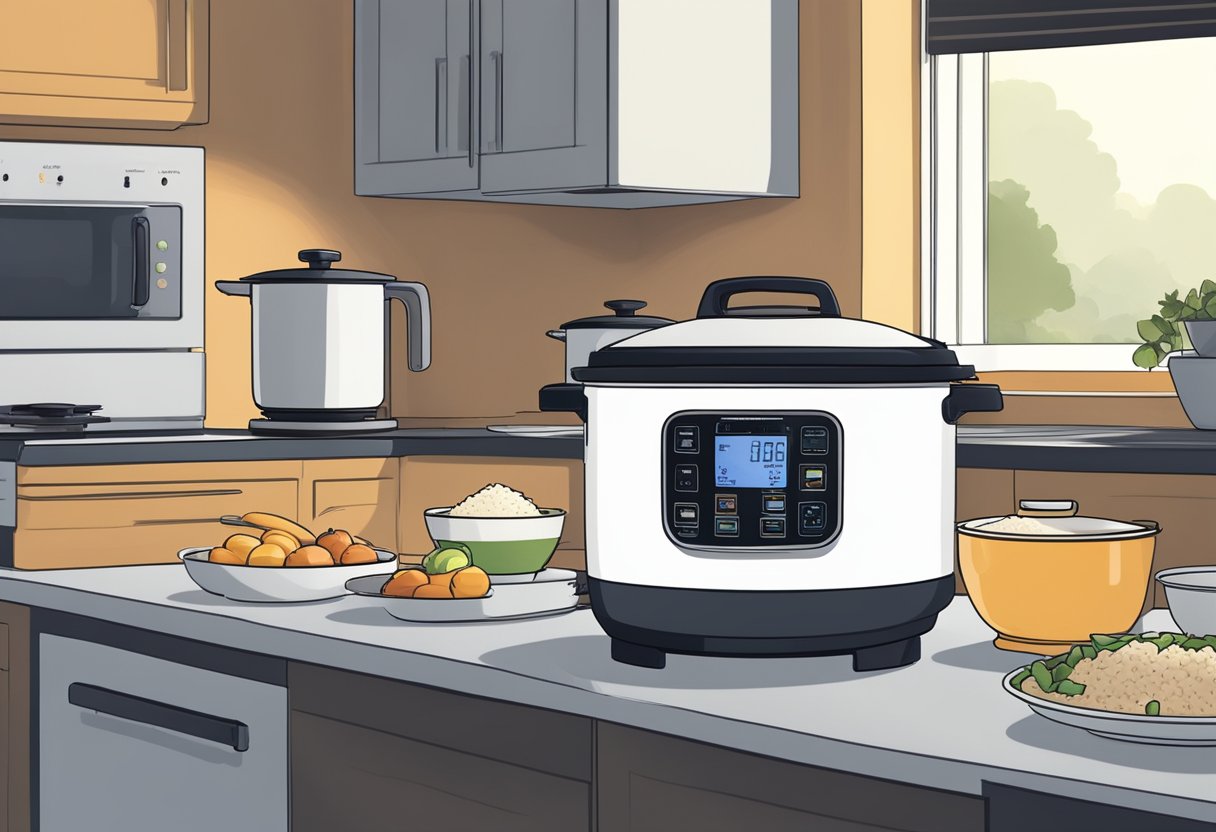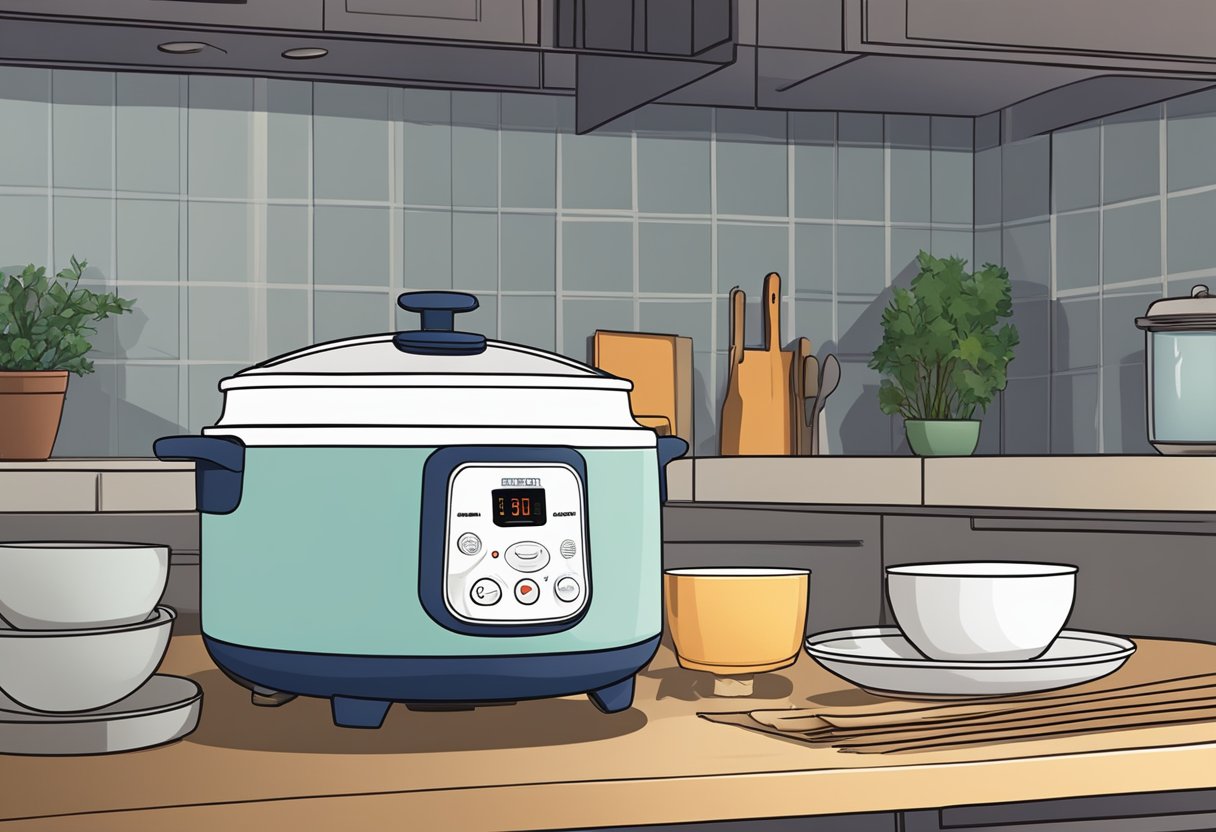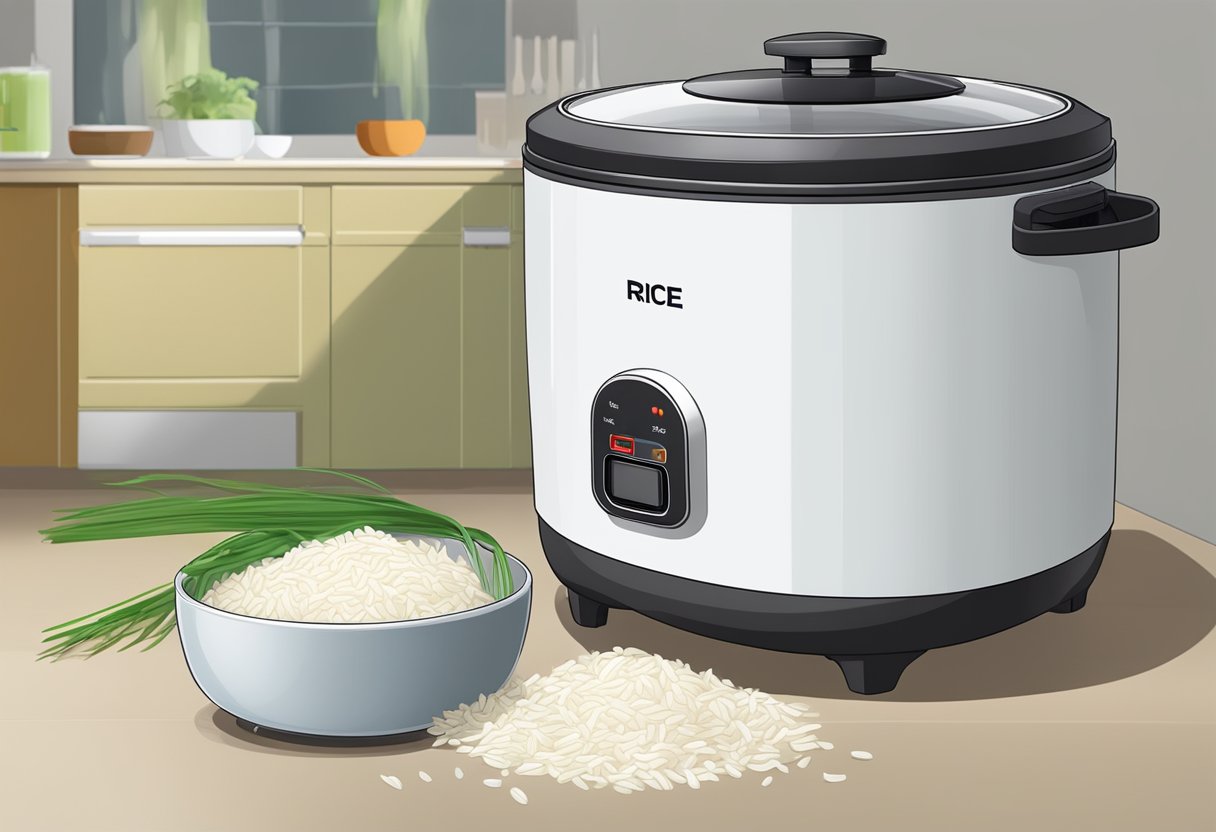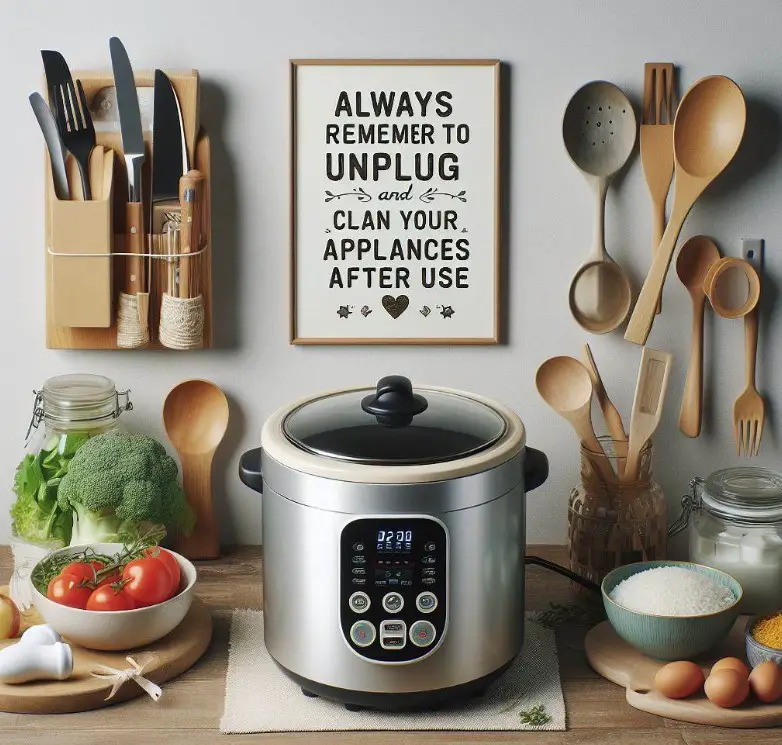I have researched and compiled information on whether a rice cooker can be left out overnight. Rice cookers are a convenient kitchen appliance that can make cooking rice easier and faster. However, there are concerns about whether it is safe to leave cooked rice in the rice cooker overnight.

Understanding Rice Cookers
Rice cookers are designed to cook rice and keep it warm until it is ready to be served. They work by heating the rice and water to a boiling point and then reducing the heat to a simmer until the rice is cooked.
Once the rice is cooked, the rice cooker switches to a “keep warm” mode to maintain the temperature of the rice until it is ready to be served.
Food Safety Concerns
Leaving cooked rice in the rice cooker overnight can be risky as it can lead to food poisoning. Bacteria like Bacillus cereus can multiply in cooked rice left at room temperature for more than 2 hours.
These bacteria produce toxins that can cause food poisoning, resulting in unpleasant symptoms like vomiting, cramps, and diarrhea. It is recommended to store cooked rice in the refrigerator or freezer within 2 hours of cooking to prevent bacterial growth.
Key Takeaways
- Leaving cooked rice in a rice cooker overnight can lead to food poisoning.
- Cooked rice should be stored in the refrigerator or freezer within 2 hours of cooking to prevent bacterial growth.
- Rice cookers are designed to cook rice and keep it warm until it is ready to be served.
Understanding Rice Cookers

Rice cookers are an essential appliance in many kitchens. They are designed to cook rice to perfection, and some models even come with additional features that make cooking rice even easier. In this section, I will explain how rice cookers work and explore some of the modern features that you can find in these appliances.
How Rice Cookers Work
Rice cookers work by using heat to cook rice in a pot. The pot is usually made of aluminum or stainless steel and has a non-stick coating to prevent the rice from sticking to the bottom. The rice cooker has a heating element that is located at the bottom of the pot. This heating element heats up the pot and the water in it. When the water reaches boiling point, it turns into steam and cooks the rice.
Once the rice is cooked, the rice cooker automatically switches to the “keep warm” feature. This feature keeps the rice warm and prevents it from getting cold. The keep warm feature works by using residual heat to keep the rice warm. It is important to note that the keep warm feature is not designed to cook rice, but rather to keep it warm.
Modern Rice Cooker Features
Modern rice cookers come with a variety of features that make cooking rice even easier. Some of these features include:
- Delayed start: This feature allows you to set a timer for when you want the rice cooker to start cooking. This is especially useful if you want to have rice ready when you come home from work.
- Fuzzy logic: This feature allows the rice cooker to adjust the cooking time and temperature based on the type of rice and the amount of water in the pot. This ensures that the rice is cooked to perfection every time.
- Multiple cooking settings: Some rice cookers come with multiple cooking settings, such as brown rice, white rice, and sushi rice. This allows you to cook different types of rice with ease.
While rice cookers are convenient and easy to use, it is important to use them safely. Leaving a rice cooker on overnight is generally not recommended, as it can be a fire hazard. If you need to keep rice warm for an extended period, it is better to transfer it to a heat-safe container and store it in the refrigerator.
Food Safety Concerns
As someone who cooks regularly, it’s essential to ensure that the food you prepare is safe for consumption.
Leaving rice in a rice cooker overnight can pose some food safety concerns that you should be aware of. In this section, I will discuss some of the common food safety concerns associated with leaving rice in a rice cooker overnight.
Bacteria and Rice
Rice is a staple food in many cultures and is often cooked in large quantities. However, rice can be a breeding ground for bacteria if not handled correctly. Bacteria thrive in warm, moist environments, and rice left in a rice cooker overnight can provide the perfect breeding ground for bacteria to grow.
Bacillus Cereus in Cooked Rice
One of the most common types of bacteria found in rice is Bacillus cereus. This bacterium can cause food poisoning if consumed in large quantities. Bacillus cereus is a spore-forming bacterium that can survive even when the rice is cooked. If rice is left out at room temperature, the spores can grow into bacteria and multiply.
Preventing Food Poisoning
To prevent food poisoning, it’s essential to handle rice correctly. Here are some tips to prevent food poisoning from rice:
- Store cooked rice in the refrigerator within two hours of cooking.
- Reheat rice thoroughly before consuming it.
- Do not leave rice in a rice cooker for more than four hours.
- Always wash your hands before handling rice or any other food.
In conclusion, leaving rice in a rice cooker overnight can pose some food safety concerns. Bacteria can grow in warm, moist environments, and cooked rice can be a breeding ground for bacteria if not handled correctly. To prevent food poisoning, it’s essential to handle rice correctly and follow the tips mentioned above.
Storing Cooked Rice Safely
As someone who loves to cook, I often find myself with leftover rice that I want to save for later. However, it’s important to know how to store cooked rice safely to avoid the risk of food poisoning. Here are some best practices for storing cooked rice:
Refrigeration Best Practices
Cooked rice should be refrigerated as soon as possible, ideally within two hours of cooking. It’s important to use a clean, airtight container to store the rice. The refrigerator should be set to 40°F or below to keep the rice fresh and safe to eat.
Using Airtight Containers
Using an airtight container is essential to keep the rice fresh and prevent it from absorbing any odors or flavors from other foods in the refrigerator. Airtight containers also prevent the rice from drying out, which can make it unappetizing and difficult to reheat.
Freezing Cooked Rice
If you don’t plan on eating your leftover rice within four to six days, it’s best to freeze it. Freezing cooked rice is a great way to extend its shelf life and prevent it from going to waste. However, it’s important to use airtight containers or freezer bags to prevent freezer burn and keep the rice fresh.
Overall, storing cooked rice safely is essential to avoid the risk of food poisoning. By following these best practices for refrigeration and freezing, you can enjoy your leftover rice safely and easily.
Risks of Leaving Rice in a Rice Cooker Overnight

As someone who has cooked rice in a rice cooker before, I know how tempting it can be to leave the rice in the cooker overnight. However, doing so comes with several risks that you should be aware of. In this section, I will discuss some of the potential risks of leaving rice in a rice cooker overnight.
Bacterial Growth and Spoilage
One of the main risks of leaving rice in a rice cooker overnight is the potential for bacterial growth and spoilage. According to Rice Array, it’s generally safe to leave cooked rice in a rice cooker for up to 12 hours. However, after that time, the rice can begin to spoil and become unsafe to eat.
When rice is cooked, it creates an ideal environment for bacterial growth. If the rice is left in the rice cooker overnight, the warm and moist environment can promote the growth of harmful bacteria, such as Bacillus cereus, which can cause food poisoning.
To reduce the risk of bacterial growth and spoilage, it’s best to refrigerate the rice as soon as possible after cooking.
Texture and Taste Deterioration
Another risk of leaving rice in a rice cooker overnight is the potential for texture and taste deterioration. When rice is left in a rice cooker for an extended period, it can become dry, hard, and lose its flavor. The longer the rice sits in the cooker, the more likely it is to lose its texture and taste.
According to Kitchen Cuddle, the cooked rice will start spoiling and be unsafe for consumption if you leave it for too long. Therefore, it’s best to consume the rice as soon as possible after cooking to ensure that it retains its texture and taste.
Potential Fire Hazard
Leaving a rice cooker on for an extended period can also pose a potential fire hazard. While rice cookers are designed to turn off or switch to “Keep Warm” mode when the rice is done, there is still a remote possibility of the device causing a fire or short circuit during this stage.
According to Kitchen Snitches, it’s not recommended to leave a rice cooker on for an extended period, especially if you’re not at home to monitor it. To reduce the risk of a fire hazard, it’s best to unplug the rice cooker after use and store it in a safe place.
In summary, leaving rice in a rice cooker overnight comes with several risks, including bacterial growth and spoilage, texture and taste deterioration, and potential fire hazard. It’s best to consume the rice as soon as possible after cooking and refrigerate any leftovers promptly.
The Impact of Temperature on Rice Quality
As someone who enjoys rice, I have often wondered about the impact of temperature on rice quality. After some research, I have found that temperature plays a crucial role in maintaining the quality of rice, especially when it comes to storing it.
Optimal Temperature for Rice Storage
According to my research, the optimal temperature for storing rice is between 4°C to 10°C (40°F to 50°F) [1]. At this temperature, rice can be stored for up to six months without any significant loss of quality. However, if the temperature is too low, rice can become dry and lose its flavor.
On the other hand, if the temperature is too high, rice can become moist and attract bacteria, which can lead to spoilage and food poisoning. Therefore, it is essential to store rice at the right temperature to maintain its quality and ensure its safety for consumption.
Effects of Residual Heat
When it comes to leaving rice in a rice cooker overnight, the residual heat can affect the quality of the rice. If the rice is left in the cooker on the “keep warm” setting for too long, it can become mushy and lose its texture [1]. Additionally, if the rice is left in the cooker for too long, it can start to spoil and become unsafe for consumption.
Therefore, it is recommended to transfer the rice to a separate container and store it in the refrigerator if it is not going to be consumed immediately. This will help to maintain the quality of the rice and ensure its safety for consumption.
In conclusion, temperature plays a crucial role in maintaining the quality of rice. It is essential to store rice at the right temperature to maintain its quality and ensure its safety for consumption.
When it comes to leaving rice in a rice cooker overnight, it is recommended to transfer the rice to a separate container and store it in the refrigerator to maintain its quality and ensure its safety for consumption.
Reheating and Serving Leftover Rice
As with any leftover meals, it’s important to reheat rice properly to avoid food poisoning. If you have leftover rice from your rice cooker, you can safely reheat it for a quick and easy meal. However, there are a few things to keep in mind to ensure safety and maintain the quality of the rice.
Safe Reheating Techniques
When reheating leftover rice, it’s important to make sure it reaches a temperature of at least 165°F (74°C) to kill any harmful bacteria that may have grown on it.
One safe way to reheat rice is by using the microwave, but make sure to cover the rice with a microwave-safe lid or plastic wrap to prevent moisture from escaping. You can also add a tablespoon or two of water to the rice to help it steam and stay moist.
Another safe way to reheat rice is by using the stovetop. Place the rice in a saucepan with a tablespoon or two of water and cover with a lid. Heat the rice over medium heat, stirring occasionally, until it reaches the desired temperature.
Maintaining Rice Quality When Reheating
While reheating rice, it’s important to maintain its quality to avoid ending up with dry, hard, or mushy rice. To maintain the quality of the rice, avoid reheating it for too long or at too high of a temperature. This can cause the rice to dry out or become overcooked.
If you have a rice cooker with a “keep warm” setting, you can use this feature to keep your leftover rice warm until you’re ready to serve it.
However, make sure to only use this feature for a maximum of 12 hours, as leaving rice out for too long can increase the risk of food poisoning. If you plan on keeping your rice for longer than 12 hours, store it in the refrigerator and reheat it using one of the safe techniques mentioned above.
In summary, reheating leftover rice from a rice cooker can be done safely and easily by using the microwave or stovetop.
Make sure to reach a temperature of at least 165°F (74°C) and avoid overheating to maintain the quality of the rice. If you plan on keeping your rice warm for an extended period of time, use the “keep warm” setting on your rice cooker for a maximum of 12 hours.
Energy Consumption and Efficiency
Rice Cooker Energy Usage
When it comes to energy consumption, rice cookers are generally considered to be energy-efficient appliances. According to my research, a standard rice cooker draws a relatively low amount of voltage and amperage, consuming anywhere between 620-700 watts of electric power in cook mode [1]. This means that rice cookers use less energy than most other kitchen appliances like ovens, microwaves, and toasters.
Keep Warm Function and Energy
One of the most useful features of a rice cooker is the “keep warm” function. This feature allows the rice cooker to maintain a warm temperature after the rice has finished cooking. However, it’s important to note that this feature also uses electricity.
Once the rice is cooked, the appliance then only uses about 30-45 watts on the warm setting [1]. While this is significantly less than the cooking mode, it’s still important to consider the energy usage of this function if you plan on leaving your rice cooker on for extended periods of time.
When it comes to unattended use of rice cookers, it’s important to consider the energy consumption of the keep warm feature.
While it’s generally safe to leave rice in a rice cooker overnight on warm, in so long as the keep warm function maintains the rice at a temperature above 75° Celsius or 145-165° Fahrenheit [1], it’s important to be mindful of the energy usage during this time.
If you plan on leaving your rice cooker on for extended periods of time, it may be more energy-efficient to turn it off and reheat the rice when you’re ready to eat it.
In conclusion, while rice cookers are generally considered to be energy-efficient appliances, it’s important to be mindful of the energy consumption of the keep warm feature if you plan on leaving your rice cooker on for extended periods of time.
Turning off the rice cooker and reheating the rice when you’re ready to eat it may be a more energy-efficient option.
Best Practices for Rice Cooker Maintenance
As someone who frequently uses a rice cooker, I know how important it is to properly care for and maintain this appliance. Here are some best practices that I recommend for rice cooker maintenance.
Cleaning and Care
Regular cleaning is essential to keep your rice cooker in good working condition. After each use, unplug the cooker and allow it to cool down before cleaning. Use a soft, damp cloth to wipe down the interior and exterior of the rice cooker. Avoid using abrasive cleaners or metal scrubbers, which can damage the non-stick coating.
To clean the lid and inner pot, use a mild dish soap and a non-abrasive sponge. Rinse thoroughly and dry completely before storing. If there is any stubborn residue, soak the pot in warm, soapy water for a few minutes before cleaning.
Avoiding Damage from Metal Utensils
It’s important to use the right utensils when cooking with a rice cooker. Metal utensils, such as spoons or spatulas, can scratch the non-stick coating and cause damage to the rice cooker. Instead, use plastic or wooden utensils, which are gentler on the non-stick surface.
When serving the rice, use a plastic or silicone serving spoon to avoid scratching the inner pot. If you do accidentally scratch the non-stick coating, it’s best to replace the pot to prevent further damage.
Proper cleaning and care, as well as using the right utensils, can help extend the life of your rice cooker and keep it in good working condition. By following these best practices, you can ensure that your rice cooker will continue to provide you with delicious, perfectly cooked rice for years to come.
Types of Rice and Their Shelf Life
As a rice lover, I know how important it is to get the most out of my rice cooker. Whether you’re using a rice cooker for white rice or brown rice, it’s essential to understand the shelf life of your rice. In this section, I’ll discuss the types of rice and their shelf life.
White Rice vs. Brown Rice
White rice and brown rice are two of the most commonly consumed types of rice. White rice is more commonly used in rice cookers due to its shorter cooking time, but brown rice is also a popular choice.
White rice has a longer shelf life than brown rice due to its lower oil content. Brown rice has a higher oil content, which makes it more susceptible to spoilage. Brown rice typically has a shelf life of about six months, while white rice can last up to a year if stored properly.
Determining Rice Shelf Life
Determining the shelf life of rice can be tricky, as it depends on a variety of factors. These factors include the type of rice, the storage conditions, and whether the rice has been cooked or not.
Cooked rice typically has a shorter shelf life than uncooked rice. Rice that has been left out overnight is also more susceptible to spoilage. If you’re unsure whether your rice is still good to eat, it’s always better to err on the side of caution and throw it out.
To extend the shelf life of your rice, it’s important to store it in an airtight container in a cool, dry place. Avoid storing rice in the fridge, as this can cause condensation to form, which can lead to spoilage.
In conclusion, understanding the shelf life of your rice is essential for getting the most out of your rice cooker. Whether you’re cooking brown rice or white rice, it’s important to store your rice properly and avoid leaving cooked rice out overnight.






















